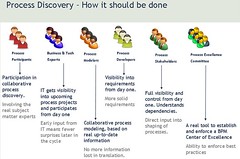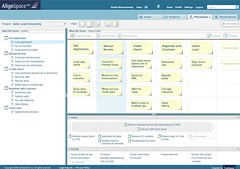Although social software and BPM is an underlying theme in a lot of the presentations that I give, today at the Business Rules Forum is the first time that I’ve been able to focus exclusively on that topic in a presentation for more than 3 years. Here’s the slides, and a list of the references that I used:
References:
- The seminal papers on Web 2.0 and Enterprise 2.0: What Is Web 2.0 by Tim O’Reilly and Enterprise 2.0: The Dawn of Emergent Collaboration and Andrew McAfee.
- Web 2.0 and BPM, the presentation where I first started talking about BPM and social software, from the BPMG conference in 2006.
- Collaborative BPM: Drivers and Impacts, a paper that I wrote for the Handbook on Business Process Management, to be published by Springer something this year.
- Richard Hirsch of Siemens has a series of introductory posts about social BPM, starting with Social BPM: A Taxonomy + The Playing Field, Social BPM: Definitions and Dissensions and Community-focused BPM: Lessons Learned from SAP’s Enterprise Services Community.
- Other general discussions of BPM and social software can be found at Social Networking and BPM of the Future by Rashid Khan, Social Technologies Will Drive The Next Wave Of BPM Suites by Clay Richardson of Forrester, and Take advantage of Web 2.0 for next-generation BPM 2.0 by Pradip Roychowdhury and Diptiman Dasgupta of IBM.
- The collaborative BPM modeler within Google Wave was described in Gravity – Collaborative Business Process Modelling within Google Wave by Alexander Dreiling of SAP, and in Very Quick Thoughts on Gravity: BPM / Google Wave integration by Richard Hirsch.
- I summarized a Gartner presentation on BPM in the cloud in Pursuing Process Agility Goals Using SaaS.
- Christina Lau of IBM gave a paper on BPM 2.0 – A REST based architecture for next generation workflow management at the Devoxx conference, highlighting the lightweight integration models that we can expect to see as social software impacts BPM; mashups and BPM within the enterprise are also discussed by Lauren Kelly in Enterprise mashups bring IT, LOB collaboration to BPM.
- Both Michael Rosemann and I cover the topics of BPM and Twitter, him at Where BPM and Twitter could meet and me at BPM and Twitter (and other social destinations).
- I cover several different BPM social networking communities of practice in Lombardi Blueprint update, Community participation in a hosted BPM system, and AlignSpace social BPM community. You can also find a BPMN community site online; Birgit Hapfelmeier, a grad student at QUT (which has a top-notch BPM program), discussed other communities in Business Process Modelling using Social Networks, as well as Scott Francis of BP3 in The Rise of Social BPM Tools.
There are many other references in this field; feel free to add your favorites in the comments section.





